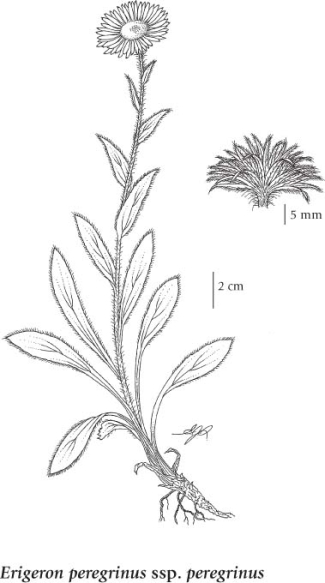Erigeron peregrinus (Banks ex Pursh) Greene subsp. peregrinus
subalpine daisy (subalpine fleabane)
Asteraceae (Aster family)
Introduction to Vascular Plants
subalpine daisy (subalpine fleabane)
Asteraceae (Aster family)
Introduction to Vascular Plants
Map
Distribution of Erigeron peregrinus subsp. peregrinus
Click here to view the full interactive map and legend
Species Information
General:
Perennial herb from a rhizome or short, stout stem-base; stems erect, simple, glabrous to moderately long-hairy below, usually densely long-hairy beneath the heads, 5-70 cm tall.
Leaves:
Basal leaves linear-lanceolate to linear-oblanceolate or broadly oblanceolate to spoon-shaped, tapering to the stalk, glabrous, often long-fringed with small hairs on the margins or sometimes sparsely long-hairy on the main veins or over the entire surfaces, 1-20 cm long, 0.2-4.5 cm wide; lower stem leaves similar; middle and upper stem leaves linear to broadly egg-shaped, occasionally more or less clasping, up to 8 cm long and 3 cm wide, sometimes lacking in smaller forms.
Flowers:
Heads with ray and disk flowers, mostly solitary, sometimes as many as 8, the disks 10-25 mm wide; involucres 7.5-11 mm tall; involucral bracts glandular and rarely with a few hairs (ssp. callianthemus) or long-hairy or sometimes sticky and fringed with small hairs (ssp. peregrinus), linear, tapering to a slender tip, loose, mostly rather leafy and about equal; ray flowers 30-80, reddish- to dark-purplish, lavender or sometimes white, 8-25 mm long, 2-4 mm wide; disk flowers 4-6 mm long.
Fruits:
Achenes asymmetrically 4- to 7-nerved, sparsely hairy; pappus single and of 20-30 bristles or double and the outer of a few scales.
Notes:
Cronquist (1947) has provided the only comprehensive treatment for this extremely variable complex. Unfortunately, he was unable to observe all seven varieties he recognized in the field. In the Pacific Northwest these varieties, which were based mainly on plant size and leaf shape, often grow together and show a continuous variation reflecting the harshness of the micro-habitats. Even the two subspecies recognized here intergrade frequently where the ranges overlap in BC and WA. The two subspecies may be separated as follows:
1. Involucral bracts long-hairy or sometimes sticky and fringed with small hairs margins............................ ssp. peregrinus
1. Involucral bracts glandular, rarely with a few long hairs.............................. ssp. callianthemus (Greene) Cronq.
Illustration

If more than one illustration is available for a species (e.g., separate illustrations were provided for two subspecies) then links to the separate images will be provided below. Note that individual subspecies or varietal illustrations are not always available.
Illustration Source: The Illustrated Flora of British Columbia
Ecology
Ecological Framework for Erigeron peregrinus ssp. peregrinus
The table below shows the species-specific information calculated from
original data (BEC database) provided by the BC Ministry of Forests and Range.
(Updated August, 2013)
The table below shows the species-specific information calculated from
original data (BEC database) provided by the BC Ministry of Forests and Range.
(Updated August, 2013)
| Site Information |
Value / Class |
||
|
Avg |
Min |
Max |
|
| Elevation
(metres) |
1642 | 1594 | 1690 |
| Slope
Gradient (%) |
18 | 2 | 35 |
|
Aspect (degrees) |
202 | 203 | 203 |
| Soil
Moisture Regime (SMR) [0 - very xeric; 4 - mesic; 8 - hydric] |
6 | 5 | 7 |
| Modal
Nutrient Regime
Class |
D | ||
| #
of field plots species was recorded in: |
2 | ||
| Modal
BEC Zone Class |
BAFA | ||
|
All BEC Zones (# of stations/zone) species was recorded in |
BAFA(1), ESSF(1) | ||
|
Source:
Klinkenberg 2013
|
|||
Habitat and Range
Wet to moist stream banks, open forests, rocky slopes and meadows in all but the steppe zone; ssp. peregrinus - common in and W of the Coast-Cascade Mountains, rare E of the Coast-Cascade Mountains, ssp. callianthemus - common throughout BC except absent on the Queen Charlotte Islands; N to AK and YT, E to AB, and S to UT, NM and CA.Status Information
Synonyms
Synonyms and Alternate Names:
Erigeron peregrinus subsp. peregrinus (Banks ex Pursh) Greene
Erigeron peregrinus var. thompsonii
Erigeron unalaschkensis Less.